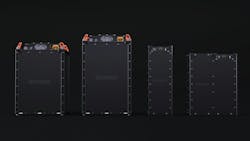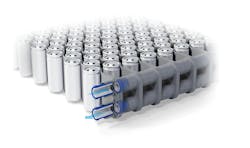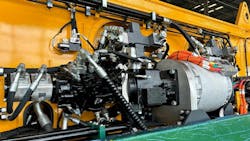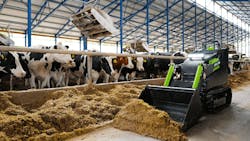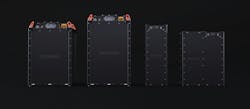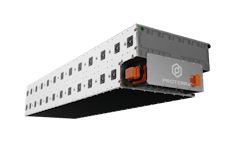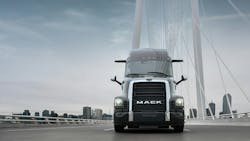Battery Technology Developments are Expanding Capabilities and Use Cases
Electrification continues to grow in many vehicle and machinery applications, due in large part to ongoing advancements in battery technology and other related systems.
Batteries are becoming more powerful and capable of charging faster, helping to expand the use case for electrification. There is also a greater focus on developing batteries and related systems for specific applications such as heavy-duty trucking and off-road machinery because of the business case electrification can offer, including reduced maintenance and operational costs.
The development of battery systems and electric vehicles therefore remains an opportunity area for many, including those developing hydraulic, pneumatic and electromechanical technologies. Fluid power systems, for instance, are being utilized both within electric vehicles as well as to produce batteries and other components.
Given the opportunities that exist in the battery and broader electric vehicle market, we’ve rounded up news highlights from the year to help Power & Motion’s audience understand where technology stands today and the various developments taking place within the market.
Freudenberg Brings Materials Expertise to Battery Cooling
Battery technology is evolving to provide extended driving range and faster charging times, necessitating development of materials to aid thermal management of advanced battery systems. Freudenberg Sealing Technologies’ fluid connectors provide such a solution.
The company has applied its materials expertise to the development of fluid connectors which can accommodate the thermodynamics of different cooling fluids under high load and ensure cooling between the battery cells. This prevents batteries from overheating, extending their service life and safe operation.
Freudenberg’s fluid connectors provide tolerance compensation and vibration resistance to assure leak-free connections — and thus consistent battery cooling — are achieved.
Danfoss Provides eHydraulic Power Module for Sany Battery Powered Crane
In early 2025, construction equipment manufacturer Sany launched its fully electric battery-operated crane. The 200-tonne lattice-boom crawler crane includes an eHydraulic Power Module from Danfoss Power Solutions’ Editron division.
The eHydraulic system integrates a Danfoss Editron synchronous reluctance assisted permanent magnet motor with a Danfoss variable displacement axial piston pump. It is used to power the traction and work function systems on the Sany battery-electric crane.
Per Danfoss, the eHydraulic module is optimized to deliver peak performance and maximize hydraulic system efficiency, helping to extend machine runtime on a single charge. The more efficiently a system like hydraulics runs, the less energy required from the machine’s battery system and thus longer run times can be achieved.
By integrating the electric motor and hydraulic pump into a single package, Danfoss was able to provide Sany with a compact and easy-to-install module. The company said this integrated design also eliminated the risk of noise, vibration, and component damage that can arise when using a flexible coupling to join the components.
Development of solutions such as this is important as hydraulics will remain an integral part of many vehicles and machines as they become more electrified, particularly heavy-duty off-highway machinery such as cranes and excavators. Enabling hydraulics and electrification technologies to work in tandem enable electric-powered machines to perform as desired while achieving emissions reduction goals.
Vanguard Adds to Battery Partner Program, Powers Electric Loader
Briggs & Stratton’s battery brand Vanguard continues to expand its partnerships with fluid power system integrators through its Battery Technology Partner Program. The most recent company to join the program is Michigan-based Depatie Fluid Power, a provider of motion and control solutions specializing in systems for industrial and mobile applications.
The Battery Technology Partner Program was established to ease the integration of Vanguard batteries into mobile equipment applications. Many OEMs, particularly small- and mid-sized equipment manufacturers, do not have the expertise in-house to develop systems for electric-powered machines.
But a company like Depatie Fluid Power can use its system integration expertise to create electrification solutions which pair Vanguard batteries with other systems, including hydraulics and pneumatics, to ensure optimized designs.
“As electrification gained momentum, our customers began asking if we could integrate battery technology with the motion and control solutions we already provide,” said Rob Knepple, Director, Engineering at Depatie Fluid Power, in Briggs & Stratton’s press release announcing the partnership. “Vanguard’s offerings are not just batteries — they’re integrated, intelligent power systems that complement the way we help our customers solve complex application challenges with complete, reliable solutions.”
At Equip Exposition 2025, taking place October 21-24, Briggs & Stratton is showing how its Vanguard 48V 7 kWh Commercial Battery (Fi7.0) is being used to power the MiniZ compact electric tracked loader from FIRSTGREEN Industries. Per Briggs & Stratton, the Fi7.0 lithium-ion battery provides the instant torque needed to achieve a 900-lb. (408 kg) lifting capacity.
The battery also features a diecast aluminum casing to protect against impact, vibration, moisture and dirt, enabling it to withstand use in harsh operating environments. Six hours of run time is provided by the battery, and it can be easily recharged using a standard 110V outlet.
Scania Launches Battery Division for Off-Road Vehicles
Heavy-duty truck and engine manufacturer Scania announced in September the launch of its newest organization, Scania Industrial Batteries. Headquartered in Sweden, the new business division will focus on development of batteries specifically for off-road and industrial applications such as mining, construction and material handling.
Specialized battery technology is required for these applications due to their size, and thus power needs, which typically cannot be met by batteries developed for passenger cars and other on-road applications. The environments in which off-road vehicles work are also harsher, requiring more durably designed technologies.
Scania launched the new battery business after its acquisition of Northvolt Systems’ Industrial Division which developed and manufactured battery systems for the off-road vehicle market.
With this acquisition and the subsequent new business launch, Scania can further expand its powertrain technology offering for the off-road and industrial vehicle markets and bring its expertise in these markets to the development of electrification solutions.
The company stated in its press release announcing the launch of Scania Industrial Batteries that it sees the market for electric off-road equipment expanding rapidly. Sectors such as construction and mining can benefit from the use of hybrid- and full-electric machines as they offer opportunities to reduce maintenance, energy costs and more.
In addition to batteries, Scania is offering electric motors, software, connectivity and support services to enable the creation of full-system solutions, as well as individual components when desired, capable of meeting the performance requirements of heavy-duty vehicles.
New Proterra Battery Powers Electric Version of Mack Pioneer Truck
Battery technology company Proterra introduced its newest battery earlier this year, the H2-23 battery packs which are designed specifically for Class 8 trucks and other commercial vehicle applications.
According to the company, the new battery pack is its most energy dense to date, enabling it to provide the power and range required by heavy-duty vehicles. The new Proterra H2-23 battery pack features a gravimetric density of 176 Wh/kg and volumetric density of 270 Wh/L, creating a 750-kWh energy system and enabling up to 2 MWh of total system energy.
With these power capabilities, the battery is able to meet the power requirements of Class 8 trucks and other similar heavy-duty applications. Electrification of larger vehicles has been challenging because of the amount of power required to move them — often necessitating several large battery packs which add weight and require a lot of installation space, a challenge for many truck and other vehicle applications.
The H2-23, however, is energy dense as well as compact in design, enabling it to meet power requirements without adding too much weight to a vehicle or taking up installation space.
Mack Trucks is one of the first OEMs to integrate the H2-23 battery pack into the battery-electric version of its Mack Pioneer. In early 2025, the company debuted the diesel-powered Mack Pioneer which it said is its most fuel-efficient truck. Upgrades to the truck’s aerodynamics, engine and transmission enable an 11% improvement in fuel efficiency compared to the previous model.
The battery-electric version is based on the diesel model, and intended for regional haul, drayage, and hub-and-spoke operations.
Proterra and Mack Trucks are both part of the Volvo Group which acquired Proterra in 2023 to advance its electric vehicle developments. This enables easier collaboration between the companies to ensure optimized technology development. Proterra also offers its battery technology to other OEMs.
CATL Introduces Three New Battery Technologies
Earlier this year, battery company CATL (Contemporary Amperex Technology Co., Limited) introduced three new batteries to the market:
- Naxtra sodium-ion batteries for passenger cars and heavy-duty trucks,
- Freevoy Dual-Power Battery, and
- second-generation Shenxing Superfast Charging Battery.
The Naxtra sodium-ion battery is considered the first mass-produced battery utilizing this chemistry. Sodium is a naturally occurring element of which there is an abundance, making it a suitable alternative to other battery chemistries relying on more finite materials. This chemistry offers various benefits including lower cost and longer range.
Two models of the Naxtra battery are available — a passenger EV Battery and a 24V Heavy-Duty Truck Integrated Start-Stop Battery. Per CATL, both batteries can perform in temperature ranges from -40 to 70 C (-40 to 158 F). The passenger EV Battery achieves an energy density of 175 Wh/kg and a range of 500 km (311 mi.). Features of the Heavy-Duty Truck Battery include deep discharge across the entire capacity, one-click starting at -40 C, and the ability to start after being idle for a year.
According to CATL, the new Freevoy Dual-Power Battery has two "independent energy zones," enabling five dual functions: dual high-voltage, dual low-voltage, dual structure, dual thermal management, and dual thermal runaway safety protection. The company states that the battery’s dual-power design and integration of software provide a stable and reliable power supply for future Level 3 and Level 4 autonomous vehicles.
Three dual-power options are available:
- Sodium-LFP Dual-Power Battery - It combines Naxtra with a LFP (lithium-iron phosphate) self-forming anode battery to take advantage of the low-temperature performance offered by sodium-ion technology with the extended range of LFP.
- LFP-LFP Dual-Power Battery – It pairs the second-generation Shenxing Superfast Charging Battery with the LFP self-forming anode battery to achieve 1,000 km (621 mi.) of pure electric range in sedans.
- NCM-LFP/NCM-NCM Dual-Power Battery – It integrates an NCM (nickel manganese cobalt) battery with an LFP self-forming anode battery, achieving a peak charging rate of 12C for the NCM battery in the main energy zone, providing over 1 megawatt of power.
Per the company, using multiple chemistries enables them to “collaborate and complement each other” to overcome some of the challenges associated with batteries relying on a single chemistry. CATL sees its dual-power batteries benefiting various applications including passenger cars, heavy-duty trucks, buses, ships and more.
The second-generation Shenxing Superfast Charging Battery is an LFP battery with an 800 km (497 mi.) range and 12C peak charging rate. CATL said it can achieve 2.5 km (1.6 mi.) of range per second of charging, helping to shorten overall charging times for vehicle owners. It is also able to charge from 5-80% within 15 minutes in low temperature environments of -10 C (14 F).
About the Author
Sara Jensen
Executive Editor, Power & Motion
Sara Jensen is executive editor of Power & Motion, directing expanded coverage into the modern fluid power space, as well as mechatronic and smart technologies. She has over 15 years of publishing experience. Prior to Power & Motion she spent 11 years with a trade publication for engineers of heavy-duty equipment, the last 3 of which were as the editor and brand lead. Over the course of her time in the B2B industry, Sara has gained an extensive knowledge of various heavy-duty equipment industries — including construction, agriculture, mining and on-road trucks —along with the systems and market trends which impact them such as fluid power and electronic motion control technologies.
You can follow Sara and Power & Motion via the following social media handles:
X (formerly Twitter): @TechnlgyEditor and @PowerMotionTech
LinkedIn: @SaraJensen and @Power&Motion
Facebook: @PowerMotionTech

Leaders relevant to this article:
